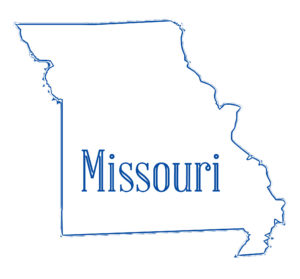Origin of The Missouri Bootheel

The Missouri bootheel forms the southeast corner of the state. It is a tag of land about thirty-seven miles wide that hangs down approximately 34.5 miles from the state’s otherwise straight southern boundary line. The eastern boundary line of the bootheel follows the course of the Mississippi river and its western boundary line follows the course of the St. Francis river. Its base runs horizontally along the parallel line of latitude of 36 degrees North, one-half degree south of the remainder of the state’s southern boundary line. Missouri’s southern boundary line, including the bootheel, forms the northern boundary line of the state of Arkansas. The story of how Missouri got its bootheel begins with the establishment of the Louisiana province in the late Seventeenth Century.
The Louisiana Province
France was the first European power to control the area of present-day Missouri. The first step in acquiring that control was taken by French explorer Father Jacques Marquette, who, accompanied by Louis Joliete and several others in two canoes, entered the Mississippi River on June 17, 1673, via the mouth of the Wisconsin River at present-day Prairie du Chien, Wisconsin. From there they traveled south to the mouth of the Arkansas River, along the southeast boundary line of the present-day state of Arkansas, where they reversed course and headed back to Canada.
The Marquette party was followed nine years later by French explorer Robert Cavalier De La Salle, who in 1682 led an expedition that entered the Mississippi River via the mouth of the Illinois River at Grafton, Illinois, just north of present-day St. Louis. From there, La Salle’s group floated the Mississippi River south to present-day New Orleans. Upon reaching the Gulf of Mexico, La Salle named the entire Mississippi valley, stretching from present-day Minnesota to present-day New Orleans, “Louisiana”, in honor of French King Louis XIV. France thus claimed dominion over the valley, commonly referred to as the Louisiana province, until 1762, when King Louis XV of France gifted the province to his cousin, King Carlos III of Spain. In practice, the transfer took several years. Eventually, Spain divided Louisiana into two regions, Upper Louisiana (Alta Luisiana) and Lower Louisiana (Baja Luisiana). According to J. Roy Reasonover, in “Reasonover’s Land Measures”, Spain situated the dividing line between the two regions at the parallel line of latitude of 36 degrees, 35 minutes North, about 450 feet north of Missouri’s present southern boundary, excluding the bootheel. Reasonover further asserts that Spain designated St. Louis, founded in 1764 by Pierre Laclede and Auguste Chouteau, as the seat of the government of Upper Louisiana and New Orleans as the capitol of the province and as the seat of the government of Lower Louisiana. On October 1, 1800, Spain agreed, by a secret treaty, to return the province to France. Then, on April 30, 1803, France agreed to sell the Louisiana province to the United States in what’s commonly known as the “Louisiana Purchase”. On November 30, 1803, Spain formally returned Lower Louisiana to France, just twenty days before France transferred control to the United States. On March 9, 1804, in a ceremony performed in St. Louis, Spain transferred control of Upper Louisiana to France, and on the following day France transferred control of the region to the United States. (Meriwether Lewis, secretary to President Thomas Jefferson, attended the ceremony, just two months prior to launching his famous expedition up the Missouri river with William Clark.)
The Missouri Territory
Wasting no time, on March 26, 1804, Thomas Jefferson signed an act of the United States Congress designating the lower portion of the province as the “territory of New Orleans” and the upper portion as “the district of Louisiana”. The act also moved the line between the upper region and the lower region to the parallel line of latitude of 33 degrees North, which is the current boundary line between the present-day states of Louisiana and Arkansas. On March 3, 1805, President Jefferson signed another act of the United States Congress, changing the name of the district of Louisiana to the Territory of Louisiana. The act also prescribed a government, of sorts, for the territory. Hardly a model of representative democracy, the act authorized the president to appoint a governor and three judges, who would act as the legislature for the new territory, establish the lower courts, and “make all laws conducive to good government”. Seven years later, on June 4, 1812, by yet another act of the United States Congress, the Louisiana Territory was renamed the Missouri Territory and provided with a structure for greater self-governance through an elected territorial legislature.
The Missouri Bootheel
In 1817, certain inhabitants of the Missouri Territory began to petition the United States Congress to form a state. One such petition, received by the United States Congress on January 8, 1818, proposed that the state’s boundaries lie “between the latitudes 36 degrees 30 minutes, & 40 degrees North and between the Mississippi river to the East and the Osage boundary line to the West.” The proposed southern boundary line of 36 degrees 30 minutes North was simply a westward extension of the boundary line dividing the states of Kentucky and Tennessee, which neighbored the Missouri Territory along the Mississippi River. Thus, this initial petition for statehood did not include the Missouri bootheel.
According to Louis Houck, in his expansive multivolume book, A History of Missouri, published in 1908, many citizens of the Missouri Territory residing just south of the proposed line of 36 degrees 30 minutes objected to their exclusion from the proposed state of Missouri. Such objectors, wrote Houck, included: the inhabitants of the village of Little Prairie, now Caruthersville, located about 22 miles south of the line of latitude at 36 degrees 30 minutes; owners of plantations adjacent to Little Prairie; and settlers along the Black River and White River. Houck writes that the people in these areas did not want “to be separated from the people with whom they were intimately associated by family, social and business ties.” They were, Houck claims, connected especially to the town of New Madrid, situated about five miles north of the line of 36 degrees, 30 minutes. On November 22, 1818, in response to these objections, the legislature of the Missouri Territory adopted a memorial petitioning the United States Congress to form a state (oddly, they did not suggest a name for the state), beginning “at a point, in the middle of the main channel of the Mississippi river, at the thirty-six degree of north latitude, and running thence, in a direct line, to the mouth of the Big Black River, (a branch of White River;) thence up the main branch of White River, in the middle of the main channel thereof, to where the parallel of thirty-six degrees thirty minutes north latitude, crosses the same”. This area encompassed a region several miles south of the present-day Missouri bootheel and extended westward below about half of the present-day southern boundary line of Missouri. The United States Congress did not adopt this proposed line.
Instead, the present southern boundary line of the state of Missouri, including its bootheel, was established on March 2, 1819, almost two and a half years prior to Missouri statehood, when the U.S. Congress formed the Arkansas Territory out of the southern portion of the Missouri Territory. The act of Congress so forming the Arkansas Territory described the northern boundary line of the Arkansas Territory as “beginning on the Mississippi river, at thirty six degrees, north latitude, running thence west to the river St. Francois; thence, up the same, to thirty-six degrees thirty minutes north latitude; and thence, west, to the western territorial boundary line”. On March 6, 1820, the United States Congress authorized the inhabitants of the Missouri Territory to form a state, the southern boundary line of which, as prescribed by the act, would be the northern boundary line of the Arkansas Territory as just described. On August 10, 1821, President James Monroe proclaimed Missouri so admitted as the twenty-fourth state of the Union.
Louis Houck writes in A History of Missouri that John Hardeman Walker, along with several local politicians and lawyers, were instrumental in keeping the bootheel within the Missouri Territory and ultimately within the state of Missouri. According to the Missouri secretary of state, in about 1810, Walker moved from Tennessee to the New Madrid area, where he raised cattle. He came to be known as the “Czar of the Valley” by amassing large tracts of land in the bootheel near present-day Caruthersville from people who fled the devastating earthquake of December 16, 1811, and its many nearly yearlong aftershocks. Although, according to Houck, the manner in which Walker secured the Missouri bootheel is “lost to history”, he asserts that “[l]ocal tradition has inseparably connected his name with the extension of the limits south to the 36th parallel between the Mississippi and St. Francois rivers.”
Authored by Michael John Sewell, founder of Sewell Law, which provides legal services in the areas of real estate, business, and civil litigation. www.sewelllaw.net; michael@sewelllaw.net; (314) 942-3232.
The choice of a lawyer is an important decision and should not be based solely upon advertisements.
© 2019 Michael John Sewell and Sewell Law, LC


